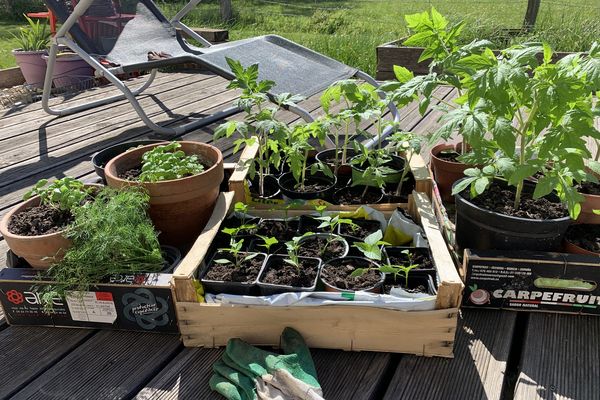The period of night frost this month of April 2021 is a disaster for arborists and winegrowers. But what about our trees, shrubs and other plants in the kitchen garden. Eric Charton, gardener expert, reassures us.
–
The episode of nocturnal frosts in mid-April 2021, which occurred after an episode of heat, is a disaster for arboriculture and viticulture professionals. The buds that had had time to bloom froze. It is the same for individuals. Our trees, shrubs and plants suffered the same fate. Yet Eric Charton, gardener expert and animator at Garden and composting relay club from Strasbourg Eurometropolis is reassuring.
What to do for fruit trees and shrubs?
Once the frost hits, there isn’t much you can do. The tree, which will not be able to bear fruit, since its buds have been scorched by frost, will “make wood“instead. In the fall you will have to carry out a severe pruning of these young woods. Until then, you can remove a few pieces of branches if they are totally blackened, but that is all. The tree knows these vagaries of the weather. He knows how to manage the crisis. This year he will, in fact, yield less fruit, but by virtue of the alternation phenomenon, he will yield more next year, in 2022.
A fruit year causes a form of stress in the tree, which is suspicious and signals to have fewer fruit flowers the following year. It is a very complex botanical phenomenon, both genetic and linked to external phenomena such as the length of the day or the temperature. In the language of gardeners, this is called flower induction. The buds that are present as early as fall determine whether they want to become flowers or leaves. The presence of seeds (or stones) in the fruit in large numbers helps the tree to proceed with this alternation.
Some mirabelle plum orchards in Meurthe-et-Moselle seem to have been spared by the wave of frost.
•
© Sophie Gueffier / FTV
–
There are species of apple trees known to be more “alternating“than others. The queen of the reinettes, for example, is customary, while the golden, the favorite of arborists, also gives each season and thus guarantees a regular production.
To remedy these periods of spring frosts, Eric’s trick is to plant varieties of late-flowering fruit shrubs: old varieties of pears, such as the curé pear, and certain currants, each species of The shrub has its late varieties. Ask your nurserymen for advice. Knowing that in addition, pollinating insects are rather cautious, it suits them better to have to do their job when the cold weather has passed.
What to do for flowering shrubs?
It does not matter for the shrubs either. The plant will grow back on the dormant buds. Just cut off the blackened ends. A rose bush or a hydrangea, for example, is pruned three times. A first pruning in the fall which consists in removing the wood: we cut the shrub in half, we call that the size squared. Then we leave the shrub alone all winter and we do the spring pruning.
If you pruned too early this year, before this frost period, you will have a little less bloom. Normally, it is first the tallest buds on the branches that flower, those that are near the sky. When we prune too early in the season, we delay the growth of buds and therefore flowers. In any case, pruned too early or on time, the bottom buds will bloom and these are the ones that interest us the most.
Know that in case of frost, your shrubs in the ground are more protected than those in pots.
What to do in the vegetable garden?
Once again, not much. If you sowed seedlings in the ground, in principle, she protected them. Check all the same, if you have had an episode of rain after the frosts, that the seeds have not rotten. But the biggest risk is falling a little behind. Up to three weeks. Carrots, parsnips, peas had to resist. Onions, shallots and garlic (a garlic, garlic) are used to winter cold, no fear. Sugar beets and salads have surely taken a hit. Transplant others.
For the plants to be transplanted, no problem since you have not yet transplanted (ideally you wait until May 13). Or if you did, it’s under a layer or a tunnel that might have saved you the worst. Especially if you’ve been careful to avoid drafts at night. Otherwise, like any self-respecting gardener, you are replanting a new series. At this time, don’t hesitate to take your young plants outside in pots, but bring them in every evening.

A little sunbath every day for your plants and especially a return indoors at the end of the day will help them to strengthen.
•
© Sophie Gueffier / FTV
–
This will help strengthen them. Eric calls them his “potty“, I really like the formula.
As for potatoes, the ideal time to plant is when your lilacs are blooming, says Eric. It seems that this is the right one phenological stage. And if you don’t have a lilac, will you tell me? Go for a walk in the neighborhood, you will eventually find one.
More generally, how to protect your garden against frost?
The methods are empirical and they have proven their worth. Replant hedges, for example, to create a protective belt around your garden or vegetable patch. This generates – all things considered – a microclimate. Avoid monocultures. Do not overwater when it is cold. Or the must, create your own temperate forest garden. Éric Charton will explain how to do this in a future article, perhaps?


/data/photo/2019/11/09/5dc5cda6a5466.png?resize=150%2C150&ssl=1)